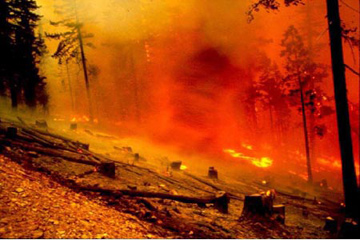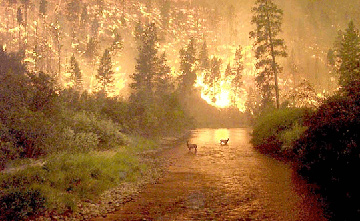California fires release 8M tons of CO2
California fires release 8M tons of CO2
mongabay.com
November 1, 2007
Southern California wildfires released 7.9 million metric tons of carbon dioxide in just the one-week period of October 19-26–the equivalent of about 25 percent of the average monthly emissions from all fossil fuel burning throughout California–according to researchers at the National Center for Atmospheric Research (NCAR) and the University of Colorado at Boulder.
Emissions from fires contribute or 4 to 6 percent (290 million tons) of annual emissions in the United States, though in some states fires may account for more carbon dioxide than fossil fuel burning in some years.
“A striking implication of very large wildfires is that a severe fire season lasting only one or two months can release as much carbon as the annual emissions from the entire transportation or energy sector of an individual state,” write scientists in a paper published Wednesday in the journal Carbon Balance and Management.
 The Kelsey Complex fire ranges in the Klamath National Forest, in 1987. Photo courtesy of Florida Division of Forestry.  Fire in Montana’s Bitterroot Valley in the year 2000. Credit: John McColgan BLM |
Though the authors warn that their estimates have a margin of error of about 50 percent due to inexact data about the extent of fires and varying estimates of the amount of carbon dioxide emitted by different types of fires, they say the results show that wildfires have a significant role in U.S. greenhouse gas emissions.
“Enormous fires like this pump a large amount of carbon dioxide quickly into the atmosphere,” said Christine Wiedinmyer, a scientist at NCAR and co-author of the paper. “This can complicate efforts to understand our carbon budget and ultimately fight global warming.”
Wiedinmyer and co-author Jason Neff of the University of Colorado say that carbon dioxide emissions from fires pose a significant challenge to policymakers working to limit greenhouse gases emissions. At a time when global politicians are debating ways to reduce emissions from deforestation and land use change, some states haven’t yet determined whether to include emissions from fires in their greenhouse gas reduction targets.
The researchers say that historic emissions from fires are difficult to determine because regrowth of vegetation can sequester much of the carbon released by burning. Nevertheless, with forecasters predicting an increasing number of fires in coming years due to climate change, emissions are expected to rise.
“The fires that are burning today in the United States are part of the legacy of the past century of fire suppression,” said Neff, an assistant professor of environmental studies. “Our attempts to control fire have had the unintended benefit of sequestering more carbon in our forests and reducing the impact of human combustion of fossil fuels. But as these forests now begin to burn, that stored twentieth century carbon is moving back into the atmosphere, where it may compound our current problems with CO2.”
This article is based on a news release from the National Center for Atmospheric Research (NCAR).
CITATION: Christine Wiedinmyer and Jason C. Neff (2007). “Estimates of CO2 from fires in the United States: Implications for carbon management.” Carbon Balance and Management October 31, 2007.